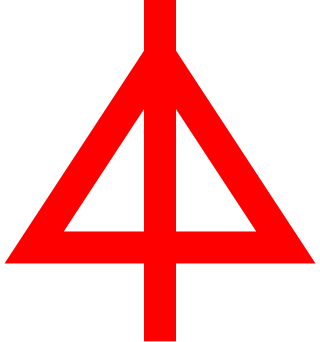The 21st Panzer Division was a German armoured division best known for its role in the battles of the North African Campaign from 1941 to 1943 during World War II when it was one of the two armoured divisions making up the Deutsches Afrikakorps (DAK). It was first formed as the 5th Light Division in early 1941.
The 9th Luftwaffe Field Division was an infantry division of the Luftwaffe branch of the Wehrmacht that fought in World War II. It was formed using surplus ground crew of the Luftwaffe and served on the Eastern Front from late 1942 to June 1944. It was badly mauled during the Soviet offensive of January 1944 near Leningrad. It was later merged with the 225th Infantry Division.
The 4th Luftwaffe Field Division was an infantry division of the Luftwaffe branch of the Wehrmacht that fought in World War II. It was formed using surplus ground crew of the Luftwaffe and served on the Eastern Front from late 1942 to June 1944 when it was destroyed during Operation Bagration.
The 6th Luftwaffe Field Division was an infantry division of the Luftwaffe branch of the Wehrmacht that fought in World War II. It was formed using surplus ground crew of the Luftwaffe and served on the Eastern Front from late 1942 to June 1944 when it was destroyed during Operation Bagration.

The 87th Infantry Division was an infantry division of the German Army during the Second World War, active from 1939 to 1945.
The 101st Jäger Division was a light infantry Division of the German Army in World War II. It was formed in July 1942 by the redesignation of the 101st (Light) Infantry Division, which was itself formed in December 1940. The Walloon Legion was briefly attached to this division from December 1941 to January 1942. The Division took part in the Battle of Kharkov, the Battle of the Caucasus, and the retreat into the Kuban, where it suffered heavy losses fighting both the Red Army and partisans. The division was then involved in the battles in the Kuban bridgehead before being evacuated. The 101st was subsequently transferred to the lower Dnieper River in late 1943. It was part of the 1st Panzer Army that was surrounded in March 1944; it formed the rear guard for the XLVI Panzer Corps during the breakout of the Kamenets-Podolsky pocket. The division then retreated across Ukraine. In October 1944, it was moved to Slovakia and took part in the Battle of the Dukla Pass.

Fortress Crete was the term used during World War II by the German occupation forces to refer to the garrison and fortification of Crete.

The 3rd Luftwaffe Field Division was an infantry division of the Luftwaffe branch of the Wehrmacht that fought in World War II. It was formed using surplus ground crew of the Luftwaffe and served on the Eastern Front from late 1942 to early 1944 at which time it was disbanded.

The 38th Infantry Division was a German Army infantry division in World War II. Formed in July 1942, it existed for a little over 15 months before being effectively destroyed in fighting on the Eastern Front in November 1943.

The 39th Infantry Division was a German Army infantry division in World War II. Formed in July 1942, it existed for a little over 15 months. Reduced to battle group size by October 1943 in fighting during the Battle of the Dnieper on the Eastern Front, it was disbanded in November 1943. Its surviving troops were absorbed by other German army formations.

The 15th Panzer Division was an armoured division in the German Army, the Wehrmacht, during World War II, established in 1940.
The 1st Luftwaffe Field Division was an infantry division of the Luftwaffe branch of the Wehrmacht that fought in World War II. It was formed using surplus ground crew of the Luftwaffe and served on the Eastern Front from late 1942 to early 1944 at which time it was disbanded.
Johannes Bäßler was a German officer in the Wehrmacht during World War II who also served in the army of Imperial Germany during World War I. During World War II, he commanded two panzer divisions on the Eastern Front. He later commanded the 242nd Infantry Division which was stationed in the south of France. He died from wounds received during the Battle of Toulon.
The 462nd Volksgrenadier Division was a Volksgrenadier division of the German Army during the Second World War, active from 1942 to 1944. It was initially known as Division Nr. 462 and subsequently became the 462nd Infantry Division before assuming its Volksgrenadier designation in late 1944.
The 335th Infantry Division was an infantry division of the German Army during the Second World War, active from 1940 to 1944. It saw active service in France and on the Eastern Front and was destroyed in fighting in Romania in August 1944.
The 336th Infantry Division was an infantry division of the German Army during the Second World War, active from 1940 to 1944. It saw active service in France and on the Eastern Front. Largely destroyed during the Crimean Offensive, it surrendered to the Soviets at Sevastopol in May 1944.
Johann Joachim Stever was a German officer in the Heer branch of the Wehrmacht during World War II who also served in the army of Imperial Germany during World War I. During World War II, he commanded the 4th Panzer Division for a period of time in 1940. He later commanded the 336th Infantry Division and was then a military area commander in occupied Russia. Promoted to generalleutnant in 1941, he retired from active duty in 1944. He fell into Soviet custody as they advanced into Germany in 1945 and, having not been seen since, is believed to have died shortly thereafter.
The 347th Infantry Division was an infantry division of the German Army during the Second World War, active from 1942 to 1945. Initially based in the Netherlands, it saw active service on the Western Front and was redesignated as a Volksgrenadier division in May 1945.

The 387th Infantry Division was an infantry division of the German Army during the Second World War, active from 1942 to 1944. It saw active service on the Eastern Front and was destroyed in fighting in Romania in August 1944.

The 376th Infantry Division was an infantry division of the German Army during World War II, active from 1942 to 1944 in two separate instances.









